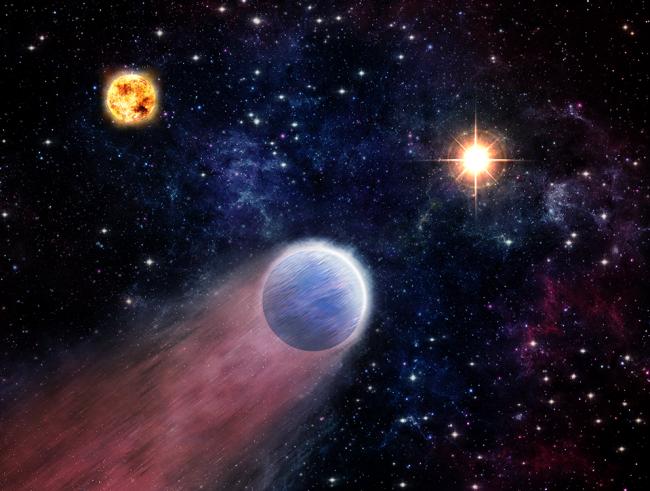
Cambridge, MA -
A team of astrophysicists and planetary scientists has predicted that Neptune-like planets located near the center of the Milky Way galaxy have been transformed into rocky planets by outbursts generated by the nearby supermassive black hole.
These findings combine computer simulations with data from recent exoplanet findings, and X-ray and ultraviolet observations of stars and black holes.
"It's pretty wild to think of black holes shaping the evolutionary destiny of a planet, but that very well may be the case in the center of our Galaxy," said Howard Chen of Northwestern University in Evanston, IL, who led the study.
Howard Chen and collaborators from the Harvard-Smithsonian Center for Astrophysics (CfA) in Cambridge, Mass., examined the environment around the closest supermassive black hole to Earth: the four-million-solar mass black hole known as Sagittarius A*.
It is well known that material falling into the black hole in occasional feeding frenzies will generate bright flares of X-ray and ultraviolet radiation. Indeed, X-ray telescopes such as NASA's Chandra X-ray Observatory and ESA's XMM-Newton have seen evidence for bright outbursts generated in the past by the black hole ranging from about 6 million years to just over a century ago.
"We wondered what these outbursts from Sagittarius A* would do to any planets in its vicinity," said John Forbes, a co-author from the CfA. "Our work shows the black hole could dramatically change a planet's life."
The authors considered the effects of this high-energy radiation on planets with masses in between Earth and Neptune that are located less than 70 light years away from the black hole.
They found that the X-ray and ultraviolet radiation would blast away a large amount of the thick, gas atmosphere of such planets near the black hole. In some cases this would leave behind a bare, rocky core. Such rocky planets would be heavier than the Earth and are what astronomers call super-Earths.
"These super-Earths are one of the most common types of planet that astronomers have discovered outside our Solar System," said co-author Avi Loeb, also of CfA, "Our work shows that in the right environment they might form in exotic ways."
The researchers think that this black hole impact may be one of the most common ways for rocky super-Earths to form close to the center of our Galaxy.
While some of these planets will be located in the habitable zone of stars like the Sun, the environment they exist within would be challenging for any life to arise. Supernova explosions and gamma ray bursts would buffet these super-Earths, which might damage the chemistry of any atmosphere remaining on these planets. Additional outbursts from the supermassive black hole could provide a knockout punch and completely erode the planet's atmosphere.
These planets would also be subjected to the gravitational disruptions of a passing star that could fling the planet away from its life-sustaining host star. Such encounters might occur frequently near the Milky Way's supermassive black hole since the region is so packed with stars. How crowded is it in the Galactic Center? Within about 70 light years of the center of the Galaxy, astronomers think the average separation between rocky worlds is between about 75 and 750 billion kilometers. By comparison the nearest star to the Solar System is 40,000 billion kilometers away.
"It is generally accepted that the innermost regions of the Milky Way is not favorable for life. Indeed, even though the deck seems stacked against life in this region, the likelihood of panspermia, where life is transmitted via interplanetary or interstellar contact, would be much more common in such a dense environment," said Loeb. "This process might give life a fighting chance to arise and survive."
There are formidable challenges required to directly detect such planets. The distance to the Galactic Center (26,000 light years from Earth), the crowded region, and the blocking of light by intervening dust and gas all make the observation of such planets very difficult.
However, these challenges may be met by the next generation of extraordinarily large ground-based telescopes. For example, searches for transits with future observatories like the European Extremely Large Telescope might detect evidence for these planets. Another possibility is searching for stars with unusual patterns of elements in their atmosphere that have migrated away from the center of the galaxy.
A paper describing these results appeared in the February 22, 2018 issue of The Astrophysical Journal Letters and is available online.
Headquartered in Cambridge, Mass., the Harvard-Smithsonian Center for Astrophysics (CfA) is a collaboration between the Smithsonian Astrophysical Observatory and the Harvard College Observatory. CfA scientists, organized into six research divisions, study the origin, evolution and ultimate fate of the universe.
For more information, contact:
Megan Watzke
Harvard-Smithsonian Center for Astrophysics
+1 617-496-7998
mwatzke@cfa.harvard.edu
Peter Edmonds
Harvard-Smithsonian Center for Astrophysics
+1 617-571-7279
pedmonds@cfa.harvard.edu
Related News
Runaway Stars Reveal Hidden Black Hole In Milky Way’s Nearest Neighbor
NASA's Hubble, Chandra Find Supermassive Black Hole Duo
Event Horizon Telescope Makes Highest-Resolution Black Hole Detections from Earth
CfA Celebrates 25 Years with the Chandra X-ray Observatory
CfA Astronomers Help Find Most Distant Galaxy Using James Webb Space Telescope
Astronomers Unveil Strong Magnetic Fields Spiraling at the Edge of Milky Way’s Central Black Hole
Black Hole Fashions Stellar Beads on a String
M87* One Year Later: Proof of a Persistent Black Hole Shadow
Unexpectedly Massive Black Holes Dominate Small Galaxies in the Distant Universe
Unveiling Black Hole Spins Using Polarized Radio Glasses
Projects
AstroAI
DASCH (Digital Access to a Sky Century @ Harvard)
For that reason, the DASCH (Digital Access to a Sky Century @ Harvard) team are working to digitize the plates for digital storage and analysis. The process can also lead to new discoveries in old images, particularly of events that change over time, such as variable stars, novas, or black hole flares.
GMACS
For Scientists
Sensing the Dynamic Universe
SDU Website